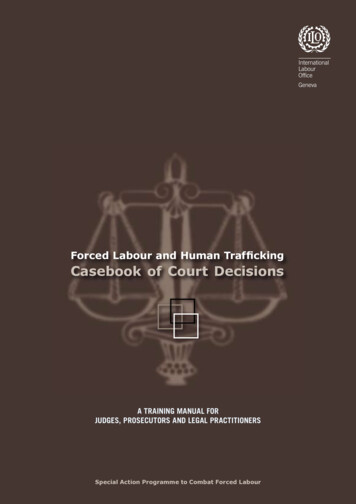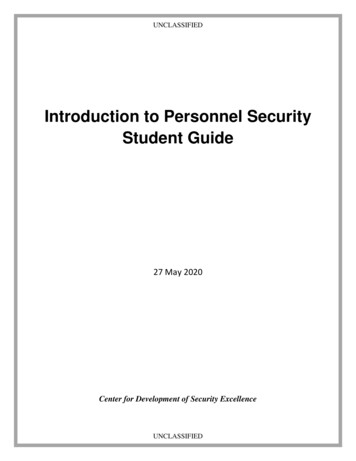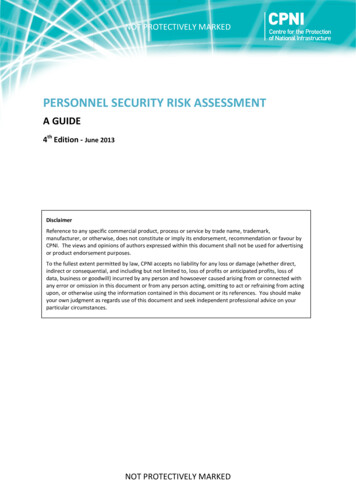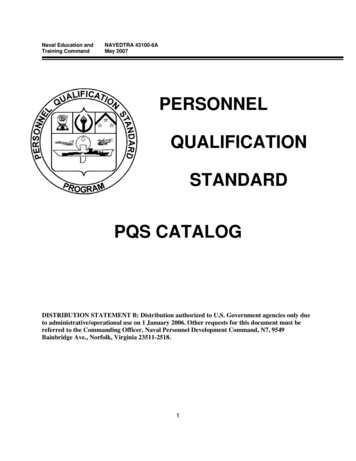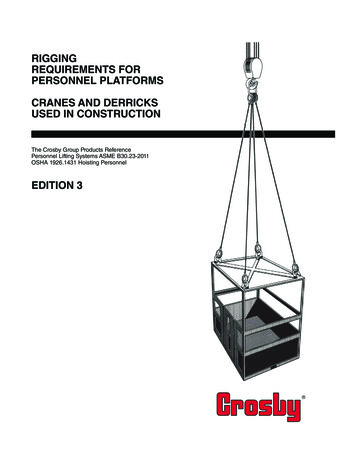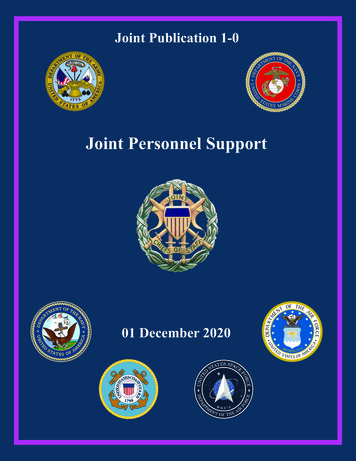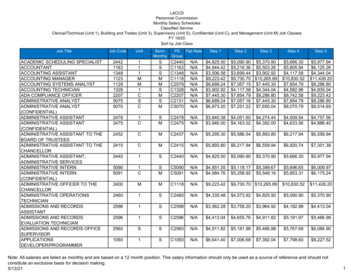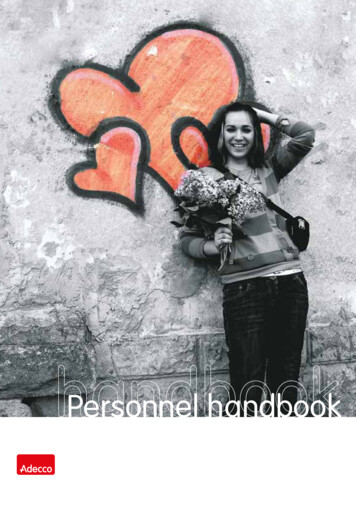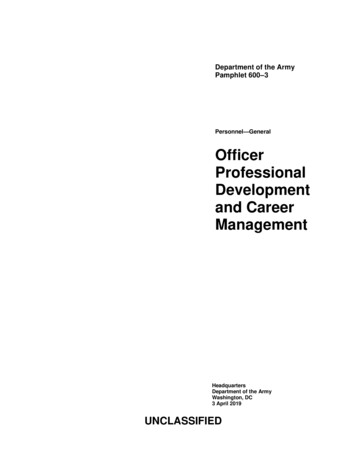
Transcription
ILO Nursing PersonnelConvention No.149Recognize their contributionAddress their needsInternational Labour Office, Geneva
Copyright International Labour Office 2005Publications of the International Labour Office enjoy copyright under Protocol 2 of the UniversalCopyright Convention. Nevertheless, short excerpts from them may be reproduced without authorization,on condition that the source is indicated. For rights of reproduction or translation, application should bemade to the ILO Publications Bureau (Rights and Permissions), International Labour Office, CH-1211Geneva 22, Switzerland. The International Labour Office welcomes such applications.Libraries, institutions and other users registered in the United Kingdom with the Copyright LicensingAgency, 90 Tottenham Court Road, London W1T 4LP [Fax: ( 44) (0)207631 5500; e-mail: cla@cla.co.uk],in the United States with the Copyright Clearance Center, 222 Rosewood Drive, Danvers, MA 01923[Fax: ( 1) (978) 7504470; e-mail: info@copyright.com] or in other countries with associated ReproductionRights Organizations, may make photocopies in accordance with the licences issued to them for thispurpose.First published 2005ISBN 92-2-118249-5 (print)ISBN 92-2-118250-9 (web pdf)The designations employed in ILO publications, which are in conformity with United Nations practice, andthe presentation of material therein do not imply the expression of any opinion whatsoever on the part ofthe International Labour Office concerning the legal status of any country, area or territory or of itsauthorities, or concerning the delimitation of its frontiers.The responsibility for opinions expressed in signed articles, studies and other contributions rests solelywith their authors, and publication does not constitute an endorsement by the International Labour Officeof the opinions expressed in them.Reference to names of firms and commercial products and processes does not imply their endorsement bythe International Labour Office, and failure to mention a particular firm, commercial product or processis not a sign of disapproval.ILO publications can be obtained through major booksellers or ILO local offices in many countries, ordirect from ILO Publications, International Labour Office, CH-1211 Geneva 22, Switzerland. Cataloguesor lists of new publications are available free of charge from the above address., or by email:pubvente@ilo.org.Visit our wWeb site: www.ilo.org/publnsPrinted by the International Labour Office, Geneva, SwitzerlandPhotocomposed in SwitzerlandPrinted in SwitzerlandBIPICO
The Nursing Personnel Convention,1977 (C 149) and the Nursing PersonnelRecommendation, 1977 (R 157)Introduction“ Recognizing the vital role played by nursing personnel, togetherwith other workers in the field of health, in the protection andimprovement of the health and welfare of the population, and noting that the present situation of nursing personnel in manycountries in which there is a shortage of qualified persons and existing staff are not always utilised to best effect, is an obstacle to thedevelopment of effective health services ”The global shortage of nursing personnel is not a new phenomenon. The wordsabove were written in the 1970’s when concern about the insufficient supply andthe ineffective deployment of nursing personnel worldwide led the InternationalLabour Organization (ILO) and the World Health Organization (WHO) tojointly develop standards for adequate nursing personnel policies and workingconditions. In 1977, these efforts resulted in the adoption of the ILO NursingPersonnel Convention (C. 149), and the accompanying Recommendation(R. 157) as international labour instruments.Today, the effective management of human resources for health has recentlyre-entered the policy agenda after a period of neglect. The challenge to implement international development programmes such as the UN MillenniumDevelopment Goals, as well as the WHO/UNAIDS “3 by 5 Initiative” have highlighted the crisis in health personnel, especially in developing countries.Worldwide, addressing the human resources for health crisis will constitute oneof the prominent health policy issues for the years to come. Within this context,nursing personnel need to be recognized both nationally and internationally fortheir important contribution to the overall objective of “health for all”.The ILO and international labour standardsBorn in 1919 from the chaos of World War One, the ILO became the firstspecialized agency of the United Nations in 1946. The tripartite structure of theILO, whose organs involve employers’ and workers’ representative along withgovernment representatives, is unique in the UN system. It currently it has 178member countries.1
The major goal of the ILO is to promote opportunities for women and men toobtain decent and productive work in conditions of freedom, equity, securityand human dignity 1. The ILO mandate emphasizes setting and adopting international labour standards to serve as guidelines for national authorities in puttingpolicies into action, backed by a system to supervise their application. Examplesinclude such hallmarks such as the 8-hour day, maternity protection, minimumage, and workplace safety conventions. All international labour standards reflecttripartite agreements.ILO standards take the form of international labour Conventions and Recommendations. The ILO’s Conventions are international treaties, subject to ratification by ILO member countries 2. Conventions are legally binding in ratifyingcountries. Recommendations are non-binding instruments complementing theConventions in providing additional orientation and guidance for nationalpolicy and action.What issues are addressed by the Nursing PersonnelConvention (C 149)?In 2002, the ILO classified the Nursing Personnel Convention (C 149) as anup-to-date instrument, reaffirming its relevance in today’s socio-economicrealities. This Convention is nearly 30 years old, yet sadly not much progress hasbeen made in many countries towards improving working conditions in nursing.The same concerns that prompted international attention on working conditionsin health services in the 1970’s unfortunately still prevail today. The health careprofession is not attracting enough recruits in both developed and developingcountries to keep up with demand, and in addition, it is also losing large numbersof trained personnel to areas outside the sector. For example, the number oftrained nurses who are not practising is 500,000 in the US, 35,000 in South Africa,and 15,000 in Ireland 3.The relationship between poor conditions of employment and work of nursingpersonnel and shortages is complex. Consequences may include: increasedpatient morbidity and mortality; greater levels of violence in the workplace;reduced occupational safety and health for remaining personnel; high levels ofjob dissatisfaction with intention to quit; and unsustainable patterns of healthworker migration from developing countries. The Nursing Personnel Conventionarticulates the kinds of provisions needed to address many of the identifiedproblems. It must be implemented in the greatest number of countries in orderto set decent standards of work, boost the professional and political profile ofnursing personnel, and provide incentive for nursing personnel to remain in theirjobs. Although drafted decades before, the spirit of the Convention is consistentwith the World Health Assembly Resolution on Strengthening Nursing andMidwifery of 2001 (WHA 54.12).1ILO Report of the Director-General, “Decent work”, International Labour Conference,87th session, 19992ILO.:What are international labour standards? Available rms/whatare/index.htm, accessed 29 April 20053“Health and Migration The Facts”, New Internationalist, no. 379, June 20052
The Convention recognizes the vital role of nursing personnel and other healthworkers for the health and wellbeing of populations. It sets minimum labourstandards specifically designed to highlight the special conditions in whichnursing is carried out. Aspects supported by the Convention include: adequate education and training to exercise nursing functions; attractive employment and working conditions, including career prospects,remuneration and social security; the adaptation of occupational safety and health regulations to nursingwork; the participation of nursing personnel in the planning of nursing services; the consultation with nursing personnel regarding their employment andworking conditions; dispute settlement mechanisms.How are the Nursing Personnel Convention (C 149) andRecommendation (R 157) used?The Convention and its Recommendation are intended to strengthen the rightsof nursing personnel and to guide policy makers, workers’ and employers’representatives in planning and implementing nursing policies within the framework of a given country’s overall health policy. Some examples of how C 149provisions have been applied illustrate the ratification potential of theConvention 4: In Bangladesh, the Nursing Council was established in 1983; a code ofprofessional conduct has been introduced, and the scope of educationallevels was improved by introducing a Bachelor of Science in Nursing. In Denmark, an educational reform was introduced in 1990, pursued by adecree on nurses training in 2001; the salaries of public service nurses wereadjusted and, within the Health Act, the public health nursing and homenursing services provisions were revised. In France, a decree adopted in 2000 lays down special rules for nursingaides and hospital staff in the public hospital service. In Malta, a Directorate of Nursing Services was created within theDepartment of Health in 1998. The Malta Union of Midwives wasestablished in 1990 and became the Malta Union of Midwives and Nurses(MUMN) in 1996 when nurses joined the union. The hours of work wereadjusted to conform to C 149. A dispute settlement was achieved in 2001with assistance from the ILO. In Greece, between 1994 and 1999, collective agreements on remunerationand working conditions were concluded for persons employed in the privatehealth sector; a Presidential Decree in 1995 enhanced the protection fornursing personnel concerning the risk of exposure to biological agents.4Information sources: ILO Committee of Experts on the Application of Conventions andRecommendations (CEACR), Article 22 Reports; International Digest of Health Legislation,available from www.who.int/idh3
In Norway, the regulations on the technical content of training in nursingand on the system of assessment were amended in 2001. In the Philippines, all laws regulating the practice of nursing have beenrevised within the Philippines Nursing Act, 1987. A Board of Nursing wasestablished with the aim of uniting the nursing sector and ensuring thatnurses’ concerns were heard within the Government; the integration ofnursing services and education was addressed and research was initiated onnational and international supply and demand patterns. In Tanzania, the Nurses and Midwives Registration Act, 1997, was adoptedproviding for education, training, registration, enrolment and practice ofnurses and midwives in their expanded role and scope of their practice.What are the implications of ratification?C 149 is legally binding for ratifying countries but it is not difficult to ratify dueto its intrinsic flexibility. It supplements national labour standards that lay downgeneral employment and working conditions covering all workers. C 149 isaccompanied by the non-binding Nursing Personnel Recommendation 157(R 157), which serves as guidance for the implementation of the Conventionwith more detailed and practical advice. Thirty-seven countries have ratifiedC 149. There are many other countries, employers and workers’ organizations aswell as professional associations that refer to or draw inspiration from R 157.Table 1: Countries having ratified the Nursing Personnel Convention,1977 (C laGuineaGuyanaIraqItalyJamaicaKenyaRatification 4198619871995198219831980198519841990Ratification landPortugalRussian iaUkraineUruguayVenezuelaZambia(Source: ILO – ILOLEX database; available from 851979199320031978199319831979198019831980
When a country ratifies an ILO Convention, it agrees to give it effect by law andto apply its provisions in practice. The country further agrees to the ILO’ s supervision of the measures it takes to implement the Convention5. A formal ILOsupervisory mechanism – consisting principally of a Committee of independentexperts which examines annual reports on the application of ratifiedConventions and formulates observations to the governments concerned –ensures regular reporting by governments, and includes procedures for handlingrequests or complaints from representatives of workers’ and employers’ organizations.It is understood that the implementation of a Convention may be a gradualprocess requiring a period of adjustment, especially since it involves legal actionat national level. At all stages of promotion, of ratification and of implementation of a Convention, the process of social dialogue, i.e. the involvement of government, employers’ and workers’ organizations in consultations, is critical.Regarding the Nursing Personnel Convention and Recommendation, theMinistries of Health have a key role as well as the relevant workers’ and employers’ organizations in both public and private health sectors. Together with thecompetent legislative and labour authorities, they are the ones to monitor andpromote the solutions to nursing personnel issues in a given country.What can be done to promote ratification?Raise
adjusted and, within the Health Act, the public health nursing and home nursing services provisions were revised. In France, . Philippines 1979 Poland 1980 Portugal 1985 Russian Federation 1979 Seychelles 1993 Slovenia 2003 Sweden 1978 Tajikistan 1993 Tanzania 1983 Ukraine 1979 Uruguay 1980 Venezuela 1983 Zambia 1980. When a country ratifies an ILO Convention,it agrees to give it effect .

